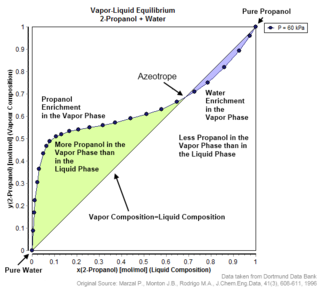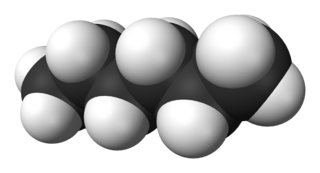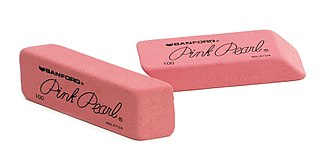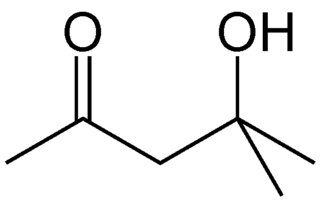
Adhesive, also known as glue, cement, mucilage, or paste, is any non-metallic substance applied to one or both surfaces of two separate items that binds them together and resists their separation.

A solvent is a substance that dissolves a solute, resulting in a solution. A solvent is usually a liquid but can also be a solid, a gas, or a supercritical fluid. Water is a solvent for polar molecules, and the most common solvent used by living things; all the ions and proteins in a cell are dissolved in water within the cell.

An azeotrope or a constant heating point mixture is a mixture of two or more components in fluidic states whose proportions cannot be altered or changed by simple distillation. This happens because when an azeotrope is boiled, the vapour has the same proportions of constituents as the unboiled mixture. Azeotropic mixture behavior is important for fluid separation processes.

Hexane or n-hexane is an organic compound, a straight-chain alkane with six carbon atoms and the molecular formula C6H14.

Heptane or n-heptane is the straight-chain alkane with the chemical formula H3C(CH2)5CH3 or C7H16. When used as a test fuel component in anti-knock test engines, a 100% heptane fuel is the zero point of the octane rating scale (the 100 point is 100% iso-octane). Octane number equates to the anti-knock qualities of a comparison mixture of heptane and iso-octane which is expressed as the percentage of iso-octane in heptane, and is listed on pumps for gasoline (petrol) dispensed globally.

Butanone, also known as methyl ethyl ketone (MEK) or ethyl methyl ketone, is an organic compound with the formula CH3C(O)CH2CH3. This colorless liquid ketone has a sharp, sweet odor reminiscent of acetone. It is produced industrially on a large scale, but occurs in nature only in trace amounts. It is partially soluble in water, and is commonly used as an industrial solvent. It is an isomer of another solvent, tetrahydrofuran.

Varnish is a clear transparent hard protective coating or film. It is not to be confused with wood stain. It usually has a yellowish shade due to the manufacturing process and materials used, but it may also be pigmented as desired. It is sold commercially in various shades.

The organic compound 1,1,1-trichloroethane, also known as methyl chloroform and chlorothene, is a chloroalkane with the chemical formula CH3CCl3. It is an isomer of 1,1,2-trichloroethane. A colourless and sweet-smelling liquid, it was once produced industrially in large quantities for use as a solvent. It is regulated by the Montreal Protocol as an ozone-depleting substance and as such use has declined since 1996.

A permanent marker or indelible marker is a type of marker pen that is used to create permanent or semi-permanent writing on an object.

An eraser is an article of stationery that is used for removing marks from paper or skin. Erasers have a rubbery consistency and come in a variety of shapes, sizes, and colors. Some pencils have an eraser on one end. Erasers come in all kinds of shapes and colors. Less expensive erasers are made from synthetic rubber and synthetic soy-based gum, but more expensive or specialized erasers are made from vinyl, plastic, or gum-like materials.

Industrial processes are procedures involving chemical, physical, electrical, or mechanical steps to aid in the manufacturing of an item or items, usually carried out on a very large scale. Industrial processes are the key components of heavy industry.

Acetone is an organic compound with the formula (CH3)2CO. It is the simplest and smallest ketone. It is a colorless, highly volatile and flammable liquid with a characteristic pungent odor.
Nitrile rubber, also known as nitrile butadiene rubber, NBR, Buna-N, and acrylonitrile butadiene rubber, is a synthetic rubber derived from acrylonitrile (ACN) and butadiene. Trade names include Perbunan, Nipol, Krynac and Europrene. This rubber is unusual in being resistant to oil, fuel, and other chemicals.

An acrylate polymer is any of a group of polymers prepared from acrylate monomers. These plastics are noted for their transparency, resistance to breakage, and elasticity.

Diacetone alcohol is an organic compound with the formula CH3C(O)CH2C(OH)(CH3)2, sometimes called DAA. This colorless liquid is a common synthetic intermediate used for the preparation of other compounds, and is also used as a solvent.

In fire protection, an accelerant is any substance or mixture that accelerates or speeds the development and escalation of fire. Accelerants are often used to commit arson, and some accelerants may cause an explosion. Some fire investigators use the term "accelerant" to mean any substance that initiates and promotes a fire without implying intent or malice. In Arson investigation, the significance of accelerant is to detect the presence of a such substance in order to proved that the fire is classified as an arson.
Stain removal is the process of removing a mark or spot left by one substance on a specific surface like a fabric. A solvent or detergent is generally used to conduct stain removal and many of these are available over the counter.
Isopropyl alcohol is a colorless, flammable organic compound with a pungent alcoholic odor.

Conservation and restoration of ceramic objects is a process dedicated to the preservation and protection of objects of historical and personal value made from ceramic. Typically, this activity of conservation-restoration is undertaken by a conservator-restorer, especially when dealing with an object of cultural heritage. Ceramics are created from a production of coatings of inorganic, nonmetallic materials using heating and cooling to create a glaze. These coatings are often permanent and sustainable for utilitarian and decorative purposes. The cleaning, handling, storage, and in general treatment of ceramics is consistent with that of glass because they are made of similar oxygen-rich components, such as silicates. In conservation ceramics are broken down into three groups: unfired clay, earthenware or terracotta, and stoneware and porcelain.

Iron, steel, and ferrous metals constitute a large portion of collections in museums. The conservation and restoration of iron and steel objects is an activity dedicated to the preservation and protection of objects of historical and personal value made from iron or steel. When applied to cultural heritage this activity is generally undertaken by a conservator-restorer. Historically, objects made from iron or steel were created for religious, artistic, technical, military and domestic uses. Though it is generally not possible to completely halt deterioration of any object, the act of conservation and restoration strives to prevent and slow the deterioration of the object as well as protecting the object for future use. One of the first steps in caring for iron is to examine them and determine their state, determine if they are corroding, and consider options for treatment.

















